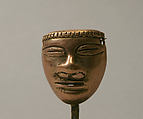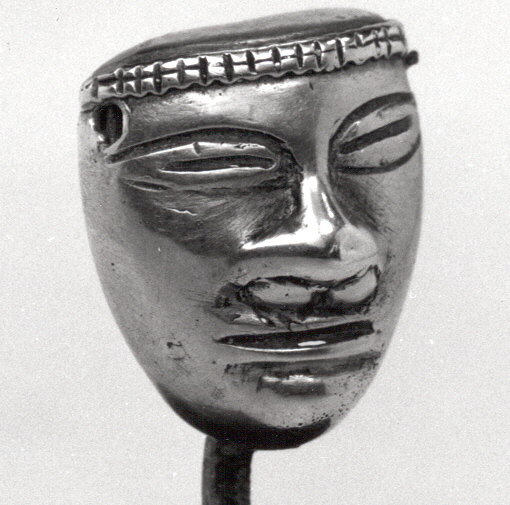Anthropomorphic Bead
Not on view
This small metal bead showing a human face was made as part of the Quimbaya tradition of metalworking. The area related to the Quimbaya tradition includes much of the Cauca Valley and part of the Central Cordillera of Colombia. A person may have worn this bead along with other beads and ornaments as part of a necklace, or the bead adorned another object or material.
On the obverse, there is a narrow band around the top of the head that consists of two rows of rectangular blocks. The eyes are elliptical, but the lines that form them are discontinuous at the outer ends. A horizontal line through the center of each eye suggests that they eyes are closed or partially closed. The nose extends outward, and a rounded ornament attached to the septum appears to be represented. The mouth is indicated by a horizontal line, and there is a small opening at the center of the mouth. A more shallow line is visible beneath the mouth, suggesting a chin. There are two circular perforations on the bead’s obverse, one in each top corner, which would have allowed the ornament to be suspended. The reverse of the object is completely open, and the facial details of the obverse are visible from this side. The top of the ornament is plain and semicircular, abutting the headband at the top of the head.
Metalworkers made this ornament by lost-wax casting likely using an alloy of gold. Adding another metal to gold, such as copper, helps with the flow of the molten metal and the reproduction of fine details in the casting. In this process, artists create a solid wax model of the object they intend to produce. Every element that is designed in wax will be eventually reproduced in metal. Artists are not solely confined to wax. Other organic materials, like resin, capable of melting out or evaporating, can also be used to form the model.
On the present example, all of the details were made by shaping wax. The artists incised the wax model in order to indicate the rectangular blocks of the headband, the eyes, nose ornament, mouth, and chin. They probably perforated the wax model with a circular tool, at this stage, too, rather than punching out these areas after the casting. The edges of the perforations are smooth and blend readily into the surrounding cast metal.
In some cases of lost-wax casting, the wax model is built around a ceramic core. This is especially the case if the intended object is hollow or has an internal cavity. For this object, a core would have been used, but it was removed after the object was cast.
Artists then design a system for the molten metal to successfully flow into the space currently occupied by the wax model. They make a wax “sprue” at the point where molten metal will be introduced, “gates” at different locations around the casting, and “runners” as long channels for the metal to reach other locations. “Risers” may be added to ensure that molten metal adequately fills certain spaces, as the metal will shrink on solidification and otherwise produce voids. Once this wax model is fully constructed, artists make a mold of the object around the wax. The mold is typically a refractory material—that is, capable of sustaining high temperatures—and usually consists of ceramic, built up from the surface of the wax model as “investment.” Artists apply the ceramic as a slurry in layers, allowing it to dry and harden. The investment around the wax model may bond with the ceramic core if it was left exposed, as would have been the case with this object.
The entire structure is then heated, melting out the wax through the added “tree” of channels. The mold, in effect, has been pre-heated, which allows for a less drastic temperature gradient at the mold-metal interface and slower cooling of the molten metal. The artists now pour molten metal, often from a crucible, into the mold. The metal enters at the sprue. Once the metal solidifies, artists will break open the hardened mold to release the cast metal object. They may finish the metal by cutting off elements of the “tree,” removing remnants of the mold, and polishing the metal surface. The entire process, depending on the size of the object, can be labor- and time-intensive and requires collaboration of several people.
In the direct lost-wax casting technique, artists build the wax model from scratch. In the indirect version, they create molds of a pre-existing model, and use these molds to form the wax model, so that they can produce metal objects that are more or less identical, as the molds are reusable. There are many examples of objects like this bead (please see below), but they exhibit variation in their design. This suggests that the beads were made by direct lost-wax casting.
The use of lost-wax casting in the past has been identified through archaeological remains (see Bray 1971 for examples from Colombia and elsewhere), and scholars often cite the process undertaken by Mexica metalworkers as described by Spanish Friar Bernardino de Sahagún and several Nahua authors (1959, Book IX, Ch. 16; 1961, Book X, Ch. 7) in the Florentine Codex, produced between 1575 and 1577 (see Pillsbury et al. 2017, cat. no. 225 for further detail). The interpretation of lost-wax casting and the vocabulary used to describe it also have been influenced by small-scale and industrial lost-wax casting as practiced by foundries around the world in recent years.
Certainly, there are varied approaches to lost-wax casting. Artists may add chaplets in the form of wooden pins to the wax model. These pins support the core of the casting as the wax melts out. Once the metal is cast and the pins burn out, the artists may fill the spaces with metal and/or ceramic. People working in the Quimbaya tradition tended to use chaplets of a notably consistent size, and they filled the spaces once occupied by the chaplets with metal (Howe 1986, 194-5).
A variety of Quimbaya objects similar to the present example has been identified. At the site of La Lorena, in the northeastern part of the Caldas department, archaeologists excavated 18 anthropormorphic beads similar to the present example within a rectangular shaft tomb (Castaño 1988, 4-5, fig. 1).[1] These beads are slightly larger than the present one, averaging 3 by 3.5 cm. They were found with human remains and gourd-shaped ceramics in the Marrón Inciso or Incised Brown style (for more information on the trajectory of this style and its association with Quimbaya metalwork, please see Bruhns 1970 and Langebaek 2016). Their number and their association with one person lends support to the proposal of Plazas (2016, 270) that a person may have worn several beads at once in order to form a necklace.
Five beads were recovered from Caramanta in Antioquia, and four more are reported from the departments of Caldas or Quindío (Pérez de Barradas 1965, pls. 6, 29). Each bead shows features akin to the present example, including a perforation in each top corner. Another from San Miguel in Antioquia displays a similar face, but with a more pronounced nose ornament and two lines that extend vertically down the face. These lines may indicate the paint a person wears on their face (see Plazas 2016). Seven other beads are noted in Restrepo (1929, pl. 27), but without provenance. Again, these show features similar to those of the present example, but sufficiently distinct to suggest each one was created from a different wax model.
Other Quimbaya metal objects show similar faces. These include a pendant that is 11 cm high and has danglers attached to its sides (British Museum 1910.12.2.5) and a range of poporos, or lime containers, that incorporate full figures, usually female, such as Metropolitan Museum of Art 1991.419.22. The depiction of these faces also draws a connection to the metalworking traditions of the Central American Isthmus, which are recognized to have been influenced by practitioners of the Quimbaya as well as the Zenú and Urabá traditions (see Fernández 2004, 35-36; Plazas 2016, 278).
The identities of the individuals who may have worn these pendants are difficult to determine. The appearance of the beads in groups, whether in archaeological contexts or in collections, suggests that they may have been connected to or worn with each other at one time. The material that was threaded through their perforations was likely organic, possibly a string of cotton or another fiber, and did not preserve up to the present day.
Even before Quimbaya metalworking became more prevalent (ca. 500-300 B.C.), metal objects played a role in social differentiation in the region. Such objects marked out certain individuals or groups of people as special, such as at the site of La Badea in Dosquebradas, Risaralda (Langebaek 2016, 286). Metal, obsidian, and shell circulated in different networks in southwestern Colombia, which includes parts of the Quimbaya region. The ability to acquire these materials gave rise to prestige but not necessarily hierarchy, instead creating networks of people based on mutualism (Gnecco 2006, 206). (For more discussion of the Quimbaya tradition and chronology, please see 1979.206.554.)
Bryan Cockrell, Curatorial Fellow, Arts of Africa, Oceania, and the Americas 2017
Related objects: 1979.206.776, 1991.419.22
[1] This excavation was undertaken for an environmental impact study for a hydroelectric project on the La Miel River adjacent to La Lorena.
Further reading
Bray, Warwick. “Ancient American Metal-Smiths.” Proceedings of the Royal Anthropological Institute of Great Britain and Ireland (1971): 25-43.
Bruhns, Karen O. “Stylistic Affinities between the Quimbaya Gold Style and a Little-Known Ceramic Style in the Middle Cauca Valley, Colombia.” Ñawpa Pacha 7-8, no. 1 (1970): 65-83.
Castaño Uribe, Carlos. “Reporte de un yacimiento arqueológico ‘Quimbaya Clásico’ en el Valle de Magdalena: Contribución al conocimiento de un contexto regional.” Boletín del Museo del Oro 20 (1988): 3-11.
Fernández Esquivel, Patricia. Museo del Oro Precolombino de Costa Rica. San José: Fundación Museos Banco Central de Costa Rica, 2004.
Gnecco, Cristóbal. “Desarrollo prehispánico desigual en el suroccidente de Colombia.” In Contra la tiranía tipológica en Colombia: Una visión desde suramérica, edited by Cristóbal Gnecco and Carl Henrik Langebaek, 191-214. Bogotá: Universidad de los Andes, 2006.
Howe, Ellen G. “A Radiographic Study of Hollow-Cast Gold Pendants from Sitio Conte.” In Metalurgia de América precolombina, edited by Clemencia Plazas, 169-200. Bogotá: Banco de la República, 1986.
Langebaek Rueda, Carl Henrik. “La arqueología Quimbaya y la maldición de Midas.” In El tesoro Quimbaya, edited by Alicia Perea, Ana Verde Casanova, and Andrés Gutiérrez Usillos, 279-289. Madrid: Ministerio de Educación, Cultura y Deporte, 2016.
Pérez de Barradas, José. Orfebrería prehispánica de Colombia: Estilos Quimbaya y otros: Láminas. Madrid: 1965.
Pillsbury, Joanne, Timothy Potts, and Kim N. Richter, eds. Golden Kingdoms: Luxury Arts in the Ancient Americas. Los Angeles: J. Paul Getty Museum, 2017.
Plazas, Clemencia. “Inventario de orfebrería Quimbaya Clásico.” In El tesoro Quimbaya, edited by Alicia Perea, Ana Verde Casanova, and Andrés Gutiérrez Usillos, 261-278. Madrid: Ministerio de Educación, Cultura y Deporte, 2016.
Sahagún, Bernardino de. Florentine Codex: General History of the Things of New Spain. Edited and translated by Arthur J. O. Anderson and Charles E. Dibble. Monographs of the School of American Research. 13 vols. Santa Fe: School of American Research; Salt Lake City: University of Utah Press, [1575-77] 1950-82.
Due to rights restrictions, this image cannot be enlarged, viewed at full screen, or downloaded.
This artwork is meant to be viewed from right to left. Scroll left to view more.



